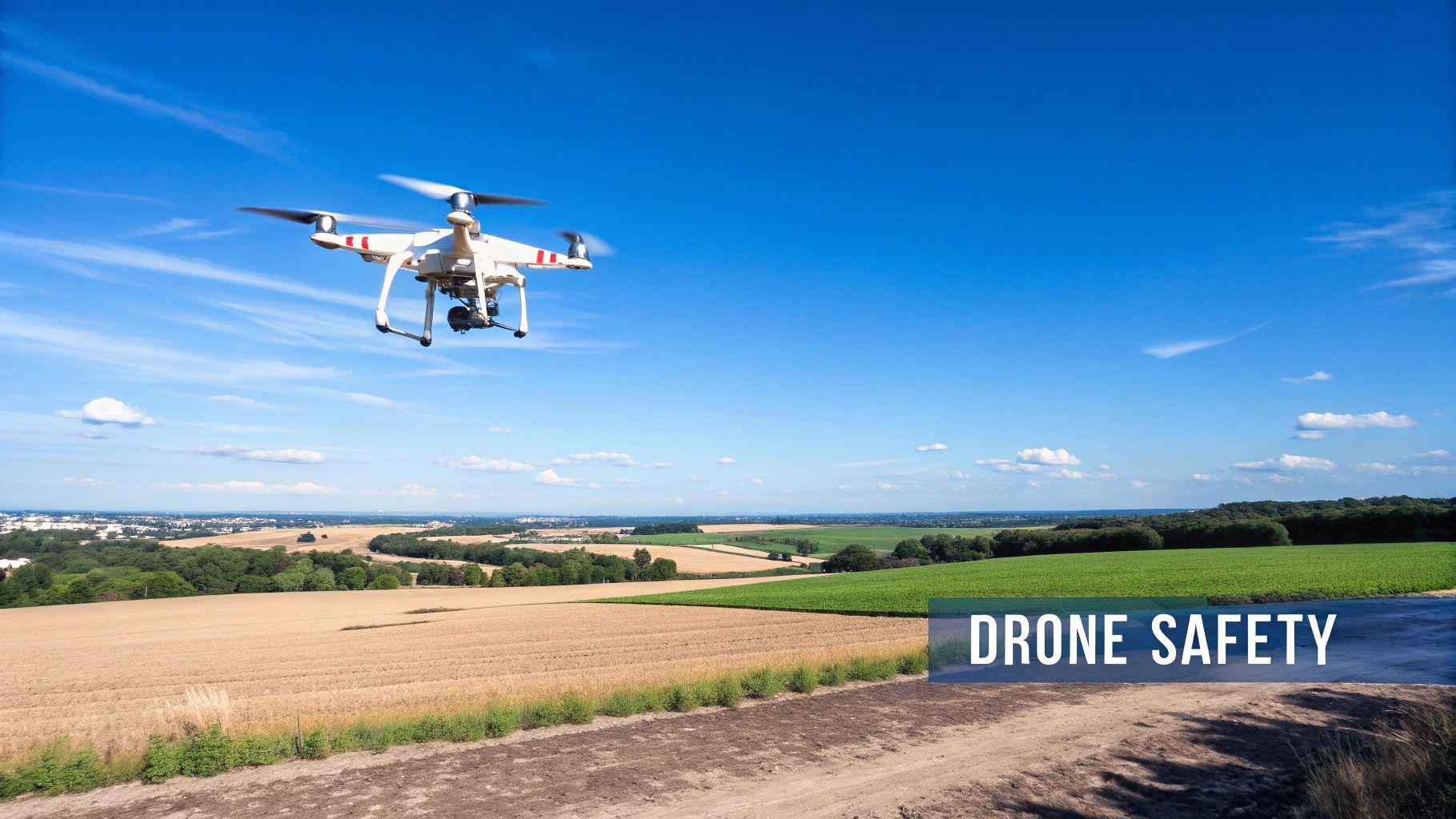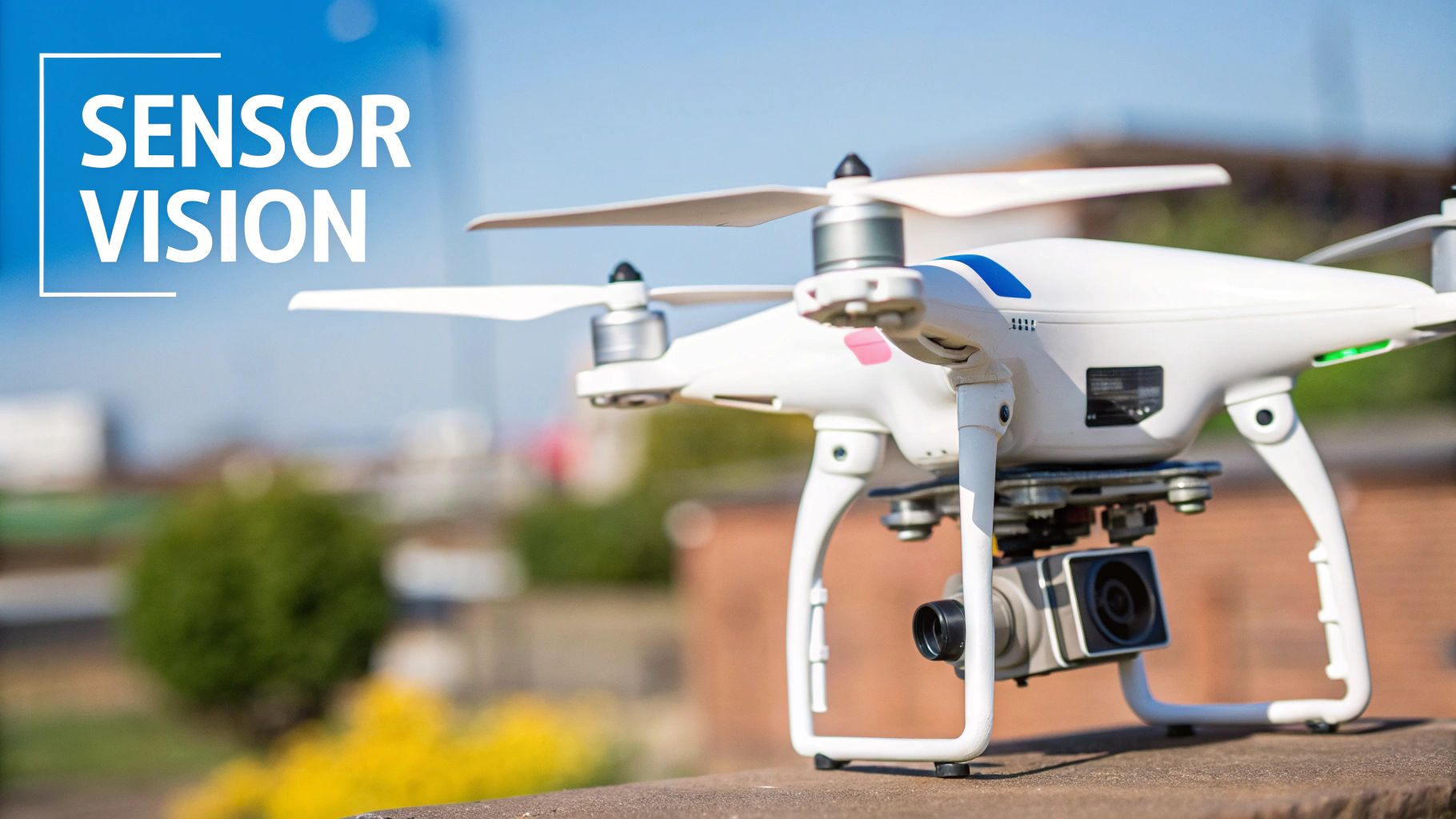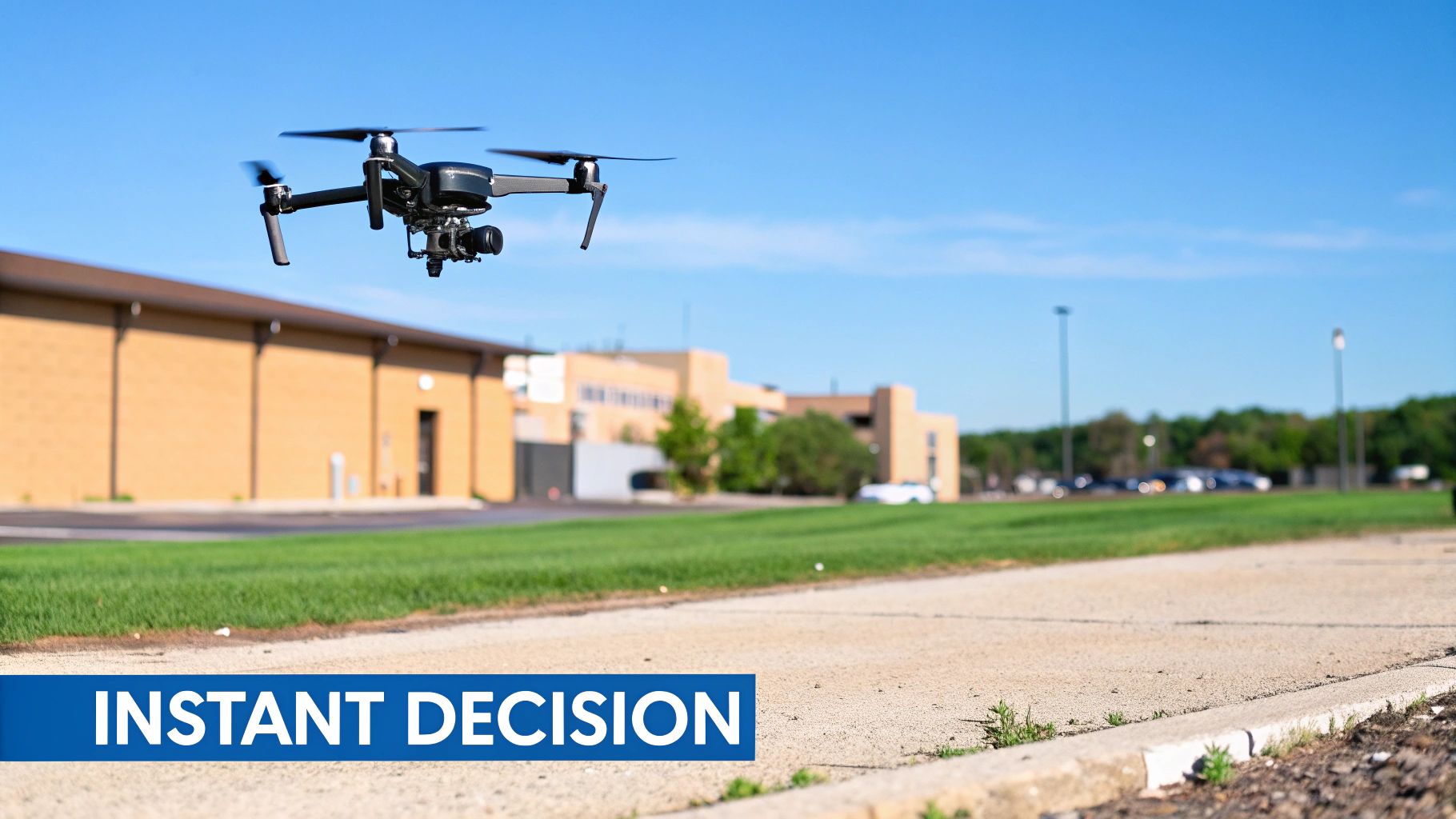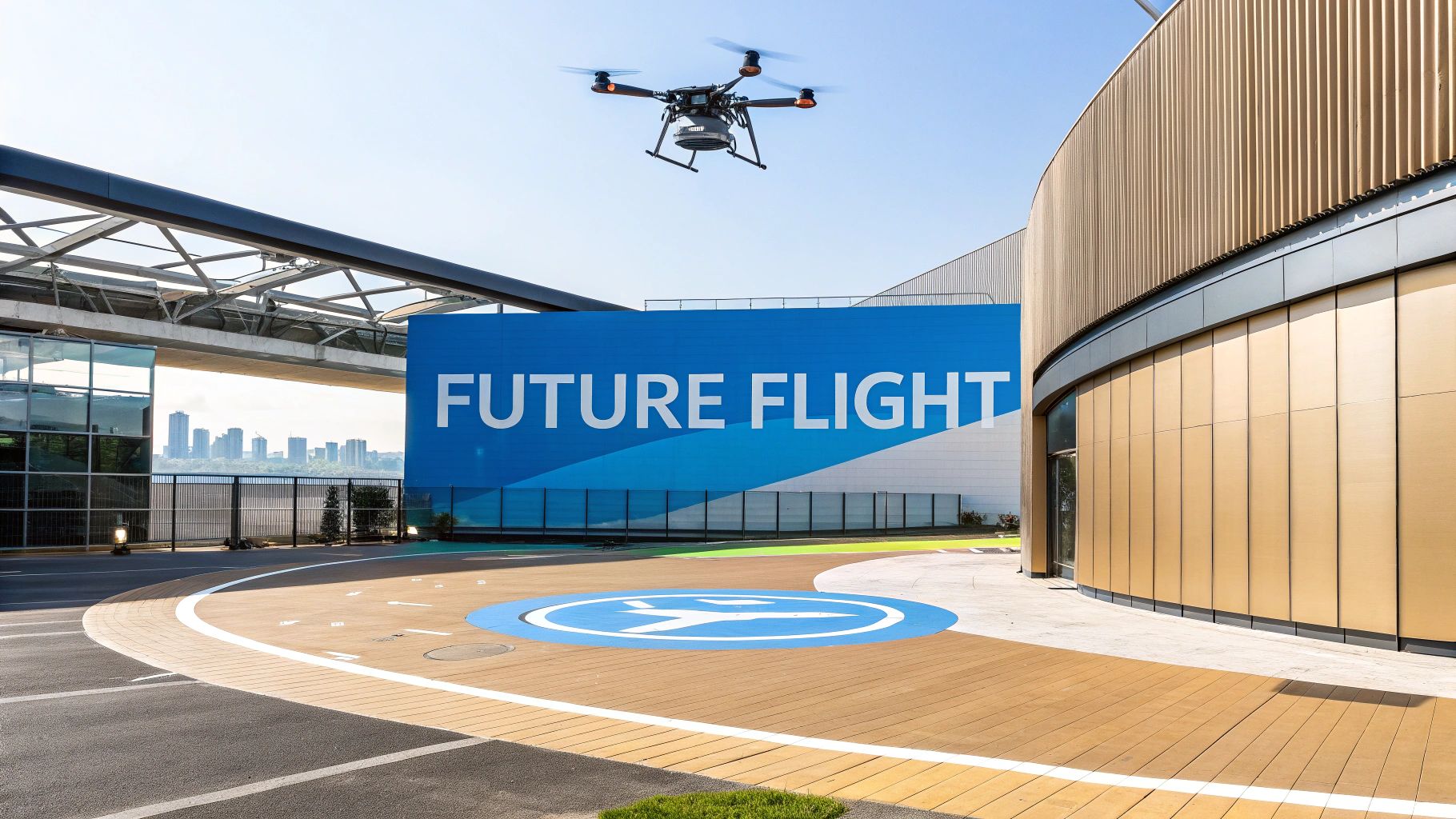Drone Collision Avoidance: Top Systems for Safer Flights
- James Baptiste

- Apr 23
- 14 min read
Why Drone Collision Avoidance Matters Now

The drone industry is experiencing rapid growth, with both recreational and commercial drone use on the rise. This increased activity leads to more congested airspace and a higher risk of collisions. These aren't just minor incidents; drone collisions present significant safety risks to people, property, and even aircraft. This makes drone collision avoidance a critical aspect of drone operations.
The Stakes Are High: Potential Consequences of Drone Collisions
Imagine the devastating consequences of a drone colliding with a commercial airliner or falling into a crowded area. The potential for damage is immense. Even seemingly small collisions can cause major disruptions and expenses. A drone hitting power lines, for instance, could cause widespread power outages. A collision between drones could damage valuable equipment and disrupt ground operations. These scenarios highlight the importance of reliable collision avoidance technology.
The increasing number of drones operating near airports is a growing safety concern. A study by Embry-Riddle Aeronautical University found 24 near-midair collisions between drones and aircraft from August 2018 to July 2021. Most occurred within 1.5 miles of a runway, underscoring the need for effective avoidance systems in these areas. The study recommends extending no-drone zones around runways to 3.5 miles for improved safety. Learn more about these near-miss collisions.
The Importance of Proactive Safety Measures
Effective drone collision avoidance isn't simply about reacting to immediate dangers; it's about proactive safety. Consider the safety features in modern cars. Seatbelts, airbags, and anti-lock brakes are essential, not because we anticipate accidents, but because they provide a safety net. Drone collision avoidance systems function similarly, protecting drones and the surrounding environment.
This proactive approach is vital for safely integrating drones into our airspace. As drone use expands, robust collision avoidance systems become even more critical for maintaining order and preventing accidents. Investing in these systems is not just a good practice; it's a fundamental requirement for the future of the drone industry. Explore more on the JAB Drone Blog.
Beyond Regulations: The Ethical Imperative
Regulations are important for drone safety, but there's also an ethical obligation to prioritize collision avoidance. Drone operators have a responsibility to ensure their flights are conducted safely and responsibly. This means taking every precaution to prevent collisions and minimize risks. By adopting drone collision avoidance technology, operators demonstrate a commitment to safety and contribute to a safer airspace for all.
The Technology Powering Collision-Free Flight

Drone collision avoidance has evolved significantly. It's no longer just about basic obstacle detection. Today's systems use a network of sensors working together to create a complete, 360-degree view of the drone's environment. This allows for complex flight maneuvers and safe operation even in challenging locations.
Understanding the Core Components: Sensors
So, what are these technologies that contribute to safer skies? Several key sensor types play crucial roles in helping drones avoid collisions.
Visual Cameras: These cameras act like the drone's eyes, capturing images of the surroundings. Advanced algorithms process the images to identify and categorize obstacles. This allows the drone to react accordingly, much like how we use our own vision to navigate.
LiDAR (Light Detection and Ranging): LiDAR uses laser pulses to precisely measure distances. This creates highly accurate 3D maps of the surrounding area, even in low-light conditions. This is particularly useful in complex environments like forests or cities.
Infrared: Infrared sensors detect heat signatures. This allows drones to see obstacles that might be invisible to the naked eye, such as animals or people in the dark.
Ultrasonic: These sensors emit sound waves and measure how long it takes for the waves to return. This gives the drone information about distance, especially helpful for detecting obstacles close by, similar to how bats use echolocation.
Radar: Radar uses radio waves to detect both objects and their movement. This is incredibly helpful in low-visibility conditions like fog or heavy rain.
Each sensor has its advantages and disadvantages. Visual cameras are affordable but don't perform well in low light. LiDAR is very accurate but can be expensive. This variety leads to the development of more sophisticated systems.
Multi-Sensor Fusion: The Power of Combined Data
Modern drone collision avoidance systems usually integrate several different types of sensors. This sensor fusion approach takes advantage of the strengths of each sensor while minimizing their weaknesses. For example, a system might combine visual cameras with LiDAR. This gives the drone both detailed imagery and precise distance measurements.
This multi-sensor fusion enables drones to fly safely in many different environments. It’s like having multiple senses providing a better understanding of the surroundings. This leads to more reliable collision avoidance. For example, a drone using visual cameras and infrared can detect both visible obstacles and heat signatures, improving its ability to avoid wildlife at night.
Beyond Simple Detection: Intelligent Avoidance Maneuvers
Today’s systems go beyond simple detection. They actively plan maneuvers to avoid obstacles. Advanced algorithms process sensor data, predict potential collisions, and calculate safe flight paths. This allows the drone to fly around obstacles without any input from the pilot. These algorithms continuously adjust the drone's flight path, ensuring a safe and smooth flight, even in complex environments.
Sensor Comparison
To better understand the different sensor technologies, the following table offers a comparison:
Collision Avoidance Sensor Showdown: A detailed comparison of different sensor technologies used in drone collision avoidance systems.
Sensor Type | Detection Range | Weather Performance | Power Requirements | Weight | Cost Range | Best Application |
|---|---|---|---|---|---|---|
Visual Cameras | Moderate | Affected by light conditions | Low | Low | Low | Daylight operations, object recognition |
LiDAR | Long | Good in most conditions | Moderate | Moderate | High | Mapping, precise navigation |
Infrared | Short to Moderate | Good in low light | Low | Low | Moderate | Detecting heat signatures, night operations |
Ultrasonic | Short | Affected by wind | Low | Low | Low | Close-range obstacle detection |
Radar | Long | Excellent in adverse weather | High | High | High | Long-range detection, all-weather operation |
As you can see, each sensor offers unique capabilities, making the choice dependent on the specific application. The convergence of these advanced sensors, intelligent algorithms, and real-time data processing is what makes current drone collision avoidance so effective. This technology paves the way for safer and more autonomous drone operations across numerous industries.
How AI Is Revolutionizing Drone Collision Avoidance

Artificial intelligence (AI) is reshaping drone collision avoidance. We're moving from basic obstacle detection to sophisticated, predictive systems. This represents a major leap forward, promising safer and more reliable drone flights. Instead of simply reacting to obstacles, AI empowers drones to anticipate and proactively avoid potential collisions.
The Role of AI in Processing Sensor Data
Modern AI algorithms process massive amounts of data from multiple sensors incredibly quickly. This rapid processing is crucial for effective collision avoidance. Data from visual cameras, LiDAR, and radar are combined to create a complete picture of the drone’s surroundings.
This allows the drone to identify threats, calculate trajectories, and execute evasive maneuvers with remarkable speed and precision. Traditional programming simply couldn't handle this level of complexity and speed. These algorithms also learn and adapt, constantly refining their ability to differentiate between various obstacles through continuous data analysis.
This means the drone can distinguish between a static building and a moving car, a bird, or even another drone. This ability to categorize objects is fundamental for making informed decisions about collision avoidance.
Training Neural Networks for Enhanced Perception
Neural networks, a core component of AI, are trained to recognize and categorize objects. This involves feeding the network huge datasets of images and sensor data so it can learn the characteristics of different objects. It's similar to teaching a child to identify different types of fruit; with enough examples, they can distinguish an apple from an orange.
Likewise, a neural network learns to distinguish between various obstacles in a drone’s environment. This advanced perception allows drones to operate safely, even in unpredictable settings. For example, in a busy urban environment, a drone encounters countless obstacles: buildings, vehicles, pedestrians, and other drones.
The AI system's ability to accurately classify these objects in real-time is essential for safe navigation. Sophisticated neural networks make this complex decision-making possible. The drone's AI can even predict the movement of dynamic obstacles like cars or people, adjusting its flight path accordingly.
Edge Computing: Bringing AI to the Drone
Edge computing now allows for powerful AI processing on battery-powered platforms. Edge computing processes data closer to the source—directly on the drone itself. This eliminates the need to send data to a remote server, which significantly reduces latency and enables faster decision-making.
This has been vital for implementing complex AI algorithms on drones, enabling real-time collision avoidance. You might be interested in: Our complete sitemap for more related content.
The global focus on airborne collision avoidance systems, including drone technology, highlights the growing importance of this area. This market reached a value of USD 1.1 billion in 2023, with projections indicating a CAGR of over 5% from 2024 to 2032.
This growth is driven by factors like increased air traffic, stricter safety regulations, and technological advancements. Find more detailed statistics here. These advancements in sensor technology and AI are enhancing detection and avoidance capabilities, potentially benefiting drone collision avoidance systems as well. This investment in research and development underscores the commitment to improving drone safety and integration into our airspace.
Multi-Drone Operations: When Swarms Need Safety

Managing a single drone in flight has its complexities. But introduce multiple drones into the same airspace, and the potential for collisions increases dramatically. Successfully navigating this intricate aerial dance requires a different approach than traditional single-drone systems. This is where the exciting field of swarm technology comes in.
Swarm Intelligence: Decentralized Control for Coordinated Flight
Swarm technology draws inspiration from nature, mirroring the elegant movements of flocks of birds and schools of fish. In these natural systems, each individual operates with a degree of autonomy, responding to its immediate surroundings and the movements of those around it. This decentralized control allows the group to move as a cohesive unit without a single leader directing every action. This same principle is at the heart of drone swarms.
Rather than relying on a central computer to micromanage every drone, each Unmanned Aerial Vehicle (UAV) makes independent decisions based on data from its own sensors and communication with nearby drones. This distributed decision-making is key for both scalability and resilience. Imagine the difficulty of controlling dozens of drones simultaneously from a single point. With swarm intelligence, each drone plays a role in the overall safety and efficiency of the group.
Inter-Drone Communication: Preventing Midair Disasters
Effective communication is fundamental to preventing collisions within a drone swarm. Drones continuously exchange information with their neighbors, sharing details about their position, speed, and intended path. This constant flow of data allows each drone to predict the movements of others and adjust its own flight path accordingly, much like cars at a busy intersection communicating their intentions through signals and lane changes.
These inter-drone communication protocols are essential for safe and coordinated flight. They provide a real-time picture of the swarm's dynamics, enabling complex maneuvers and preventing midair collisions. Consider a large-scale drone light show, where hundreds of drones might fly in close proximity, creating intricate patterns and formations. This level of coordination is only possible with robust communication.
Case Studies: Swarms in Action
Drone swarms are increasingly being used in a variety of applications, from captivating light shows to vital search and rescue missions. These real-world examples showcase the effectiveness of swarm technology and the importance of strong collision avoidance measures. In agriculture, for instance, drone swarms can efficiently survey vast fields, collecting data on crop health and pinpointing areas needing attention.
Similarly, in search and rescue operations, drone swarms can quickly cover large search areas, increasing the chances of locating lost individuals. These varied applications demonstrate the potential of drone swarms to address real-world challenges. Robust collision avoidance is crucial to realizing this potential. Statistical insights into drone collisions are critical for creating effective systems. For instance, a study on drone swarms demonstrated the effectiveness of a particular collision avoidance system under varying conditions, even with 18 and 25 drones operating simultaneously. You can explore this research further here.
Resilience and Redundancy: Handling Unexpected Scenarios
But what happens if communication is lost or a drone malfunctions? Swarm systems are designed with resilience and redundancy to address these inevitable issues. If one drone loses communication, the others can adapt, maintaining safe distances and continuing the mission, much like a flock of birds adjusting its formation after one bird suddenly alters course.
This ability to handle unexpected scenarios is essential for safe swarm operation. Consider a search and rescue mission where a drone experiences sensor failure. The swarm's resilience ensures the mission can continue, even with individual drone issues. The future of drone collision avoidance depends heavily on advancements in swarm technology, especially as drone use grows across various industries. Understanding these principles is crucial for anyone involved in operating or managing multiple UAVs.
Navigating the Regulatory Maze of Collision Standards
As drone technology progresses and drone usage expands, the demand for reliable collision avoidance systems grows. These systems are crucial not only for safety but also for adhering to increasingly strict regulations worldwide. Understanding these evolving requirements is vital for both drone manufacturers and operators.
The Global Landscape of Drone Regulations
Different countries and regions are tackling drone collision avoidance standards in various ways. While there's a global movement towards safer drone operations, the specific requirements can differ significantly. This makes it essential to stay informed about the latest rulings from aviation authorities in your operational area. Staying current ensures continued compliance and uninterrupted operations.
Regional Differences in Drone Regulations
The FAA (Federal Aviation Administration) in the United States: The FAA is actively developing regulations for drone identification and tracking, which indirectly impacts collision avoidance. These regulations aim to establish a more organized and responsible airspace for drones.
EASA (European Union Aviation Safety Agency) in Europe: EASA has implemented regulations categorizing drones based on risk, with varying requirements for each category. Some categories mandate specific collision avoidance features for drones operating in complex airspace. This system tailors regulations to specific operational needs and risk levels.
Other International Bodies: Various other aviation authorities are establishing their own regulations, often aligning with the general principles of the FAA and EASA while incorporating region-specific factors. The regulatory landscape remains complex and ever-changing.
To help illustrate the varying global regulations, the table below summarizes key requirements in major drone markets:
Global Drone Collision Avoidance Regulations: Summary of collision avoidance requirements in major drone markets worldwide
Region/Country | Governing Body | Required Capabilities | Implementation Timeline | Applicable Drone Categories |
|---|---|---|---|---|
United States | Remote ID, evolving collision avoidance standards | Ongoing | Varies by operation | |
European Union | Varies by drone category (C0-C4) | Implemented | Specific categories require detect and avoid | |
Other Regions | Varies | Developing, often aligned with FAA/EASA principles | Varies | Dependent on local regulations |
This table highlights the diverse approaches to drone regulation, emphasizing the need for operators to understand the specific requirements in their area of operation.
How Manufacturers are Meeting the Standards
Drone manufacturers are integrating progressively advanced collision avoidance systems into their products to comply with these new regulations. These systems are designed to meet specific performance benchmarks for detection range, response time, and reliability. Some manufacturers utilize advanced sensor fusion techniques combining data from multiple sensors like visual cameras, LiDAR, and radar. Others are developing AI-powered systems for predicting and autonomously avoiding potential collisions.
Understanding Certification Requirements
Specific drone operations may require certifications related to collision avoidance technology. These certifications validate the performance and reliability of the systems in use. Some regulatory bodies may require drones to meet specific standards for obstacle detection and avoidance before operating in certain airspace classifications, providing an added layer of safety assurance.
What the Future Holds for Drone Collision Avoidance Regulations
Drone regulations are constantly adapting to keep pace with technological advancements and operational needs. We can expect more refined standards focusing on specific performance metrics and operational scenarios, potentially including standards for Beyond Visual Line of Sight (BVLOS) operations, which rely heavily on robust collision avoidance capabilities. Some regulators are considering performance-based regulations that specify desired safety outcomes rather than prescribing specific technologies, promoting innovation while upholding safety.
Practical Guidance for Staying Compliant
Staying compliant with these evolving regulations can be challenging. Here are some tips:
Regularly check for updates: Stay informed about the latest regulations from your local aviation authority.
Consult with experts: Seek advice from aviation professionals or legal counsel specializing in drone regulations.
Choose certified systems: Opt for drones and collision avoidance systems that comply with relevant certification standards.
Maintain detailed records: Keep comprehensive records of your drone operations, including maintenance and flight data.
By understanding the regulatory landscape and being proactive, drone operators can ensure both safe and legal operations. Staying informed and prepared is crucial for success in this dynamic environment, allowing you to adapt to changes and utilize the full potential of drone technology.
Real-World Performance: Beyond the Spec Sheet
Manufacturers often tout impressive specs for their drone collision avoidance systems. But how do these systems perform outside the controlled environment of a lab? This is a key question for anyone considering this technology. This section explores the real-world capabilities and limitations of these systems in various situations.
Standardized Testing and Field Evaluations: Separating Hype from Reality
Rigorous testing is essential to understanding real-world performance. Standardized testing methodologies provide a consistent framework for evaluating different systems, allowing for objective comparisons. These tests assess key metrics like detection range (how far away the system can identify an obstacle) and response time (how quickly it reacts). Reliability – how consistently the system performs under different conditions – is also a crucial factor.
Beyond standardized tests, field evaluations provide invaluable insights into real-world performance. These tests expose systems to a wider range of conditions, including variations in weather, lighting, and obstacle types. Think of it like reading a restaurant review versus actually tasting the food – field tests provide a much more accurate picture.
Comparing Leading Systems: Unveiling the True Differences
Through evaluations, the true differences between systems emerge. Some excel at long-range detection, while others prioritize fast response times. For instance, radar might be better in fog, while a system using visual cameras might be more effective at recognizing specific objects in clear conditions.
Understanding these nuances is crucial for choosing the right system. Just as a hammer is best for nails and a screwdriver for screws, different drone operations require different collision avoidance capabilities.
Challenging Conditions: When Systems Are Pushed to the Limit
Real-world environments present many challenges. Poor visibility, like fog or heavy rain, can severely impact systems relying on visual sensors. High-speed encounters demand incredibly fast response times.
Evaluating performance under these conditions is critical. Some technologies, like radar in low visibility, might shine, while others may fall short. Understanding these limitations is paramount for safe operation. It's similar to knowing your car's braking distance in different weather conditions.
Practical Considerations for Choosing the Right System
Choosing the right system requires careful thought. What are your operational needs? Are you flying in open fields, dense urban environments, or challenging weather? These factors influence which system is best suited for your operations.
For example, a drone inspecting power lines in remote areas might prioritize long-range detection. A drone capturing footage in a busy city needs fast response times and the ability to navigate complex environments. Insights from experienced operators are invaluable. Their practical knowledge, gained from real-world challenges, goes beyond technical specifications. They’ve seen what works and what doesn't, helping you avoid costly mistakes and ensure safe and successful drone operations.
The Future of Drone Collision Avoidance
The current drone collision avoidance landscape relies on technologies like LiDAR, radar, and visual cameras. However, the future promises more reliable and sophisticated systems. This evolution is driven by the increasing complexity of airspace and the need to safely integrate drones.
Bio-Inspired Systems: Learning From Nature
Nature provides excellent examples of collision avoidance. Birds and insects navigate complex environments with remarkable skill. Biomimetic systems, inspired by nature, are a promising area of research. Researchers are studying insect visual systems to develop more robust drone obstacle detection algorithms. This could lead to drones that react to unexpected obstacles with greater speed and efficiency.
Quantum Sensors: The Next Leap in Precision
Quantum sensors offer the potential for remarkable precision in measuring distance and movement. These sensors use quantum mechanics to detect tiny environmental changes. This increased sensitivity could significantly improve drone collision avoidance, especially in low light or dense fog. Before deploying any collision avoidance system, a thorough preflight checklist is crucial to ensure all systems are working correctly and minimize accidents.
Advanced Materials: Lighter, Stronger, More Efficient
Sensor weight and power consumption are key factors in drone design. Advanced materials like carbon fiber composites and graphene are creating lighter, more energy-efficient sensor platforms. This allows smaller drones to be equipped with robust collision avoidance systems. Lighter drones also have increased flight times, beneficial for tasks like surveillance or delivery. These materials also enhance sensor durability.
Collaborative Initiatives: Addressing Key Challenges
Several collaborative initiatives are addressing limitations in drone collision avoidance. These initiatives bring together researchers, manufacturers, and regulators to solve challenges like miniaturization and operation in GPS-denied environments. Some researchers are developing systems using inter-drone communication to improve collision avoidance in drone swarms. This allows drones to share position and velocity data, coordinating movements and avoiding collisions.
Practical Timelines: When Will These Technologies Arrive?
Some of these technologies are still in research, while others are nearing commercial availability. We can anticipate seeing bio-inspired systems and advanced materials incorporated into drone collision avoidance within the next few years. Quantum sensors are further out, but their potential impact is substantial. You might be interested in: JAB Drone's sitemap for more drone-related resources. Ready to enhance your drone's safety and performance? Explore JAB Drone for a selection of drones and accessories.




Comments